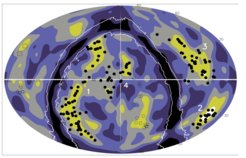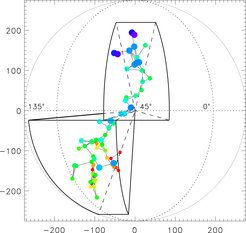New discovery in the sky: Largest superstructure in the nearby universe unveiled
A team of scientists has found the largest superstructure ever reliably characterised in the universe. The discovery was made while mapping the nearby universe using galaxy clusters detected by the ROSAT X-ray satellite's survey of the sky. With a length of about 1.4 billion lightyears, the new structure, which consists mainly of dark matter, is the largest known structure to date. Researchers at the Max Planck Institute for Extraterrestrial Physics (MPE) and the Max Planck Institute for Physics (MPP) led the study in collaboration with colleagues in Spain and South Africa.

Averaged over very large volumes, the universe appears almost homogeneous. On scales smaller than about a billion lightyears and in our cosmic neighbourhood, it is characterised by condensations of matter in superclusters and by voids. Precise knowledge of these structures is very important for cosmological research and the main motivation for mapping the nearby Universe.
“If you look at the distribution of the galaxy clusters in the sky in a spherical shell with a distance of 416 to 826 million light-years, you immediately notice a huge structure that stretches from high northern latitudes to almost the southern end of the sky,” explains Hans Böhringer, the project leader. It consists of 68 clusters of galaxies and has an estimated total mass of 2.4 1017 solar masses with a length of around 1.4 billion light years. This breaks the size record of all reliably measured cosmic structures. The largest of them so far, the “Sloan Great Wall”, for example, has a length of around 1.1 billion light years and it is located much further away.
An ATLAS of galaxy clusters
For their study, the scientists used an almost complete atlas of galaxy clusters in the nearby universe. “The catalogue was created with the help of the ROSAT X-ray satellite, built by MPE. In 1990, the satellite mapped the entire sky using a high-resolution X-ray telescope for the first time,” explains Joachim Trümper, the ROSAT project leader and emeritus Director of the MPE.
In the decades that followed, researchers worked to identify the galaxy clusters more precisely and to determine their distances. This resulted in a three-dimensional image of their distribution, in which the galaxy clusters precisely trace the structure of the large-scale distribution of matter in the universe, much like lighthouses trace a coastline. The catalogue covers the entire cosmic volume out to a distance of one billion light-years. In this region, the new structure appears much larger than all other structures.
Importance for science: cosmography and cosmology

This finding is crucial for mapping the universe, but also for cosmological measurements. The researchers have shown how the presence of these structures affects the measurement of the Hubble constant or the microwave background. The cosmic background radiation was created shortly after the Big Bang and gives us important clues about the structure and evolution of the universe. The Hubble constant indicates the current expansion rate of the universe. “Even if these are only corrections of a few percent, they become increasingly important as the accuracy of cosmological observations increases,” emphasizes Gayoung Chon from the MPP.
The scientists have named their remarkable discovery “Quipu”, a term from the language of the Incas. The Incas used bundles of strings with knots for their bookkeeping and as letters. The superstructure resembles this ancient script, appearing as a long fibre with side strands woven into it. The scientists also chose the name because most of the distance measurements of the galaxy clusters were made at the European Southern Observatory (ESO) in Chile. The earthly quipus are on display at the Archaeological Museum in the capital Santiago de Chile - bringing us back to Earth from the far reaches of the cosmos.













